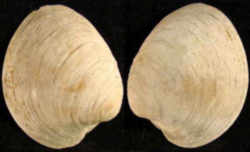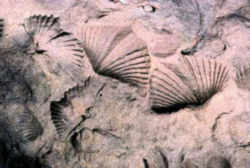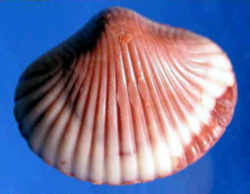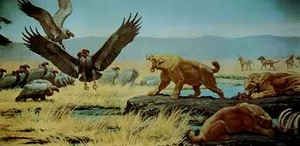
Kentucky Symbols
Kentucky State Fossil
Brachiopod (Lamp Shells)

(undetermined)
Adopted on July 15, 1986.
After lobbying by students and teachers at a Louisville middle school, the Kentucky State Legislature designated the brachiopod Kentucky state fossil on July 15, 1986 with the passage of Act 488, Section 1.
With so many species of brachiopods found throughout the state, Kentucky decided to designate the entire group as its state fossil.
Brachiopod shells are probably the most commonly collected fossil in Kentucky. Brachiopods had two shells and lived attached to the sea bottom or some object on the sea bottom.
Kentucky State Fossil: Brachiopod (Lamp Shells)

Brachiopods are fossil shells, from animals that lived in ancient seas. Most are now extinct. Although they resemble clams, brachiopods were a different group of animals. Hundreds of different types of brachiopods can be found in Kentucky. Modern brachiopods live in the sea. Because brachiopods can be found in rocks throughout Kentucky, we know that Kentucky was once covered by oceans.
Although they had two shells or valves, as clams (pelecypods) have, all similarity ends there. The internal structure of brachiopods is entirely different from that of the clam. Brachiopods still exist today but are very rarely found as seashells on the beach. However, in ancient Kentucky, they were very common and far outnumbered the fossil clams and snails living in the sea. Brachiopods can be found in Ordovician, Silurian, Devonian, Mississippian, and Pennsylvanian rocks in Kentucky.
Brachiopods are sometimes called lampshells, as they look like oil lamps. In this fossil, you can see that one shell tucks into the other. An oil lamp has a wick at one end, and its shape looks a bit like this.
Paleontology and Geology

Brachiopods were common in the warm, shallow seas that covered most of North America during the Paleozoic (~ 550-250 million years ago). Brachiopods are shellfish. There are a few brachiopod still surviving, but they used to be common. The name is derived from bracchium + poda (Latin) meaning 'arm foot'. A brachiopod attaches itself to a rock using a foot or pedicle. It has arms to catch its food.
The Precambrian and Early and Middle Paleozoic: Precambrian and Cambrian rocks are only represented by material brought up in drill cores; however, early to middle Paleozoic rocks are well-represented at the surface in Kentucky Ordovician, Silurian, and early Devonian rocks contain abundant fossils, indicating the presence of warm, shallow seas teeming with trilobites, brachiopods, corals, bryozoans, and other invertebrates. By the Late Devonian, the seas over Kentucky had become depleted in oxygen, and black muds rich in organic material began to accumulate on the sea bottom. The Carboniferous was a time of fluctuating sea levels and the formation of huge river delta systems with extensive swamps. With the exception of the far western region and the Nashville Dome, most of Kentucky is covered by these Carboniferous rocks, the source of Kentucky's vast coal deposits.
The Late Paleozoic and Mesozoic: The retreat of the extensive shallow seas of the Paleozoic left much of Kentucky exposed during the late Paleozoic (Permian) and Mesozoic; however, fossils from a few Permian rocks brought up in drill cores indicate that the shallow sea persisted in the far western part of the state. The Mesozoic is represented only by a small area of Cretaceous rock in the far western Jackson Purchase area. These rocks are mainly nearshore marine gravels and sands, deposited from rivers flowing from the north and east. Few fossils are known from this time.
The Cenozoic: Cenozoic fossils are well-preserved and fairly abundant in Kentucky. The Tertiary is represented by plant fossils, including leaves, wood, and pollen. Though not shown on this map, Quaternary glacial deposits are present in the northern part of the state, and fossils of mastodons, mammoths, giant ground sloths, bison, elk, the short-faced bear, lions, and other mammals are found in mineral springs and salt licks, as well as in caves, sinkholes, ponds, and river gravel deposits in several places around Kentucky.
Kentucky Law
The law designating the brachiopod as the official Kentucky state fossil is found in the Kentucky Revised Statutes, Title 1, Chapter 2, Section 2.082
TITLE I - SOVEREIGNTY AND JURISDICTION OF THE COMMONWEALTH.
CHAPTER 2 - CITIZENSHIP, EMBLEMS, HOLIDAYS, AND TIME.
2.082 State fossil.
The brachiopod is named and designated as the state fossil of Kentucky.
Effective:July 15, 1986
History: Created 1986 Ky. Acts ch. 488, sec. 1, effective July 15, 1986.
Taxonomic Hierarchy: Brachiopod
Kingdom: Animalia
Unranked: Spiralia
Superphylum: Lophotrochozoa
Clade: Brachiozoa
Phylum: Brachiopoda

Some states that lack a "state fossil" have nevertheless singled out a fossil for formal designation such as a state dinosaur, rock, gem or stone.






